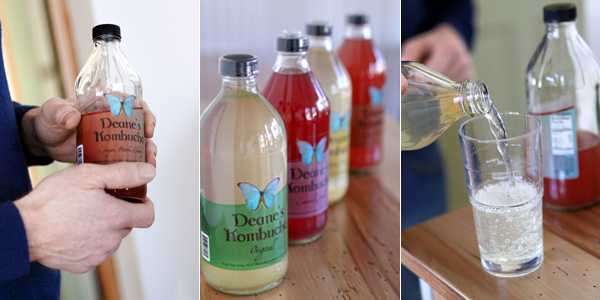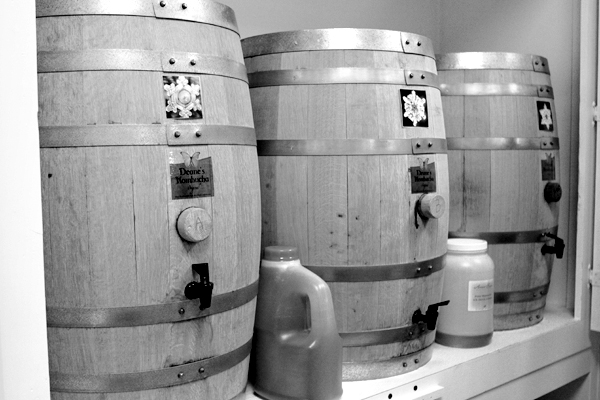
For most people, the most threatening part about brewing kombucha is the mother. It can be a difficult concept for the mind to accept: that this floppy, pancake-shaped, alien placenta-looking thing could be the main ingredient of a chic health food. Kombucha brewers who don’t want to sound like they have maternal issues call it the SCOBY, or Symbiotic Culture of Bacteria and Yeast. No wonder most people just opt to purchase it already brewed and bottled.
For starters, kombucha is basically a sour-sweet fermented tea that needs the mother to spark the fermentation process. The mother belongs to the same family as the alcohol and vinegar yeasts that most people know and love. One can acquire a mother from another brewer or by mail order. It’s much more practical to get one from a friend, since every bottle of kombucha grows a new mother.
Kombucha commonly begins with black or green tea, to which sugar and the mother are added. The tea and sugar feed the mother, which floats on top of the brew and converts the whole batch into kombucha over the course of a week or so. This is where it gets tricky.
We asked Bryan Bertsch (photo, lower right) of the St. Paul-based Deane’s Kombucha brewery to explain the next step. “It took me four years to figure out this part of the fermentation. Once you finish the first ferment, you’ve got to do a secondary ferment.”

Bertsch’s first ferment takes place in 30-gallon oak barrels, which make a much more refined alternative to the basic home brewer’s setup of crocks and cheesecloth. “I learned about using oak barrels from the Happy Herbalist. It makes a lot of sense: If you’re doing wine and beer in oak barrels, why not kombucha? It lends the finished product a much better flavor, and makes a better home for the bacteria.”
Bertsch, who also teaches classes on energy healing and meditation, adds another flavor to his kombucha. During the first ferment, he meditates and does energy work with the brew to give it fresh chi, focusing on feelings of harmony, cooperation, sharing, and reverence for life. He cites the influence of Masaru Emoto, author of several books on the effect of the mind on liquid. Fresh chi is an optional ingredient, though Bertsch believes that it really makes a difference. In a similar vein, GT’s Kombucha, a nationally popular kombucha producer, reportedly brews their kombucha with “positive energy and Indian folk music in the background.”
Once the kombucha develops the desired acidity during its first ferment, Bertsch says, you should transfer it to bottles, seal them tightly, and keep them in a temperature-controlled environment for 1-4 weeks. At this point, Bertsch also adds fruit juices for flavoring. The second ferment adds a natural carbonation to the brew, making it just as fizzy as artificially carbonated drinks such as soda. Once it reaches the right level of fizziness, you should cool the kombucha immediately to halt the fermentation process.

The kombucha that comes out of Bertsch’s brewery speaks to the level of his involvement in its creation. Though the level of alcohol in kombucha is negligible at best — the most alcoholic it tends to get hovers around 1% ethyl alcohol — it tastes surprisingly heady. In fact, Bertsch hopes to market kombucha as a non-alcoholic cocktail beverage. Coming in at an average of 50 calories per bottle, it’s fizzy and refreshing without the heaviness of soda.
However, the jury is still out on the health claims that many kombucha producers foster on their promotional material. GT’s Kombucha uses anecdotal evidence to link the drink to the remission of breast cancer. Their website also includes this story: “In his autobiography, Nobel Prize winner Alexandr Solzhenitsyn wrote that drinking Kombucha helped him survive the Siberian slave camps of the former Soviet Union.” (So stock up, just in case!)
The science supporting kombucha is minimal; like many products of this variety, anecdotal evidence far outweighs hard science. One review of the available literature on the drink (circa 2003) found no evidence to back up any of the health claims regarding kombucha. Rather, the author, Dr. Edzard Ernst, concludes that the risks of consuming the drink — i.e., liver damage, metabolic acidosis, and cutaneous anthrax infections — undermine its utility as a medicinal remedy.
According to Wild Fermentation author Sandor Ellix Katz, kombucha was the object of a huge health craze among people with HIV / AIDS in mid-1990s America. Now, it seems to be making a resurgence, and many soft drink companies have jumped on the bandwagon, acquiring kombucha producers to get in on a lucrative market. Coca-Cola company-owned Honest Tea released its own line of beverages called Honest Kombucha last year. Typically, kombucha retails at around $3-$5 a bottle, so a mother might be a nice long-term investment if you plan to incorporate it into your diet.
Bertsch teaches regular classes on homebrewing at Linden Hills Co-op.
Further reading on kombucha:
Wild Fermentation, Sandor Ellix Katz
Instructable: How to Make a Big Batch of Kombucha
Kombucha: A Systematic Review of the Clinical Evidence
Determination and characterization of the anti-microbial activity of the fermented tea Kombucha
Happy Herbalist
Kombucha Research by Michael Roussin

thanks for this- as to the value of the kombucha, I suppose at the very least the good chi and /or music played to it makes it worth more than Aquafina………I enjoy Kombucha, also make my own rejuvelac. Both drinks give me a positive energy feeling, more so than just water. It would be interesting to see if someone could measure any of the benefits in a scientific setting.
Kombucha with vodka (or is it gin?) on the rocks is a great summer drink.
During the first ferment, he meditates and does energy work with the brew to give it fresh chi, focusing on feelings of harmony, cooperation, sharing, and reverence for life. He cites the influence of Masaru Emoto, author of several books on the effect of the mind on liquid. Fresh chi is an optional ingredient, though Bertsch believes that it really makes a difference.
Oh, please.
TO YAM—I know it sounds weird. I get a twinge when I hear it from such a new agey (forgive me) vibe.
But IF you’re objective, you can look up Dr. Masauro Emoto’s work with water, and microscopy, and the effects of different emotions, and music. You can even google it.
And also, give a look at Larry Dossey’s, M.D. book “Healing Words” and he says it minus his pyramid hat. the book actually mentions experiments on bacteria growth when exposed to healers, and prayer, will either stimulate growth, or disable and reduce them when negative. The book is actually a compendium of different studies done in Hospitals and Labs, and the effects of prayer. One I remember were mice with small patches of skin removed to make a wound. One group were exposed to ‘healers’ and the other, of course, just treated normally. The skin grew back much faster on the mice who were receiving “healing” (forgive me) energy, or as that guy said, another name of energy, Chi. Doesn’t MATTER what you call it. Other studies were done on double blind studies of patients who were prayed for, unbeknown to them.